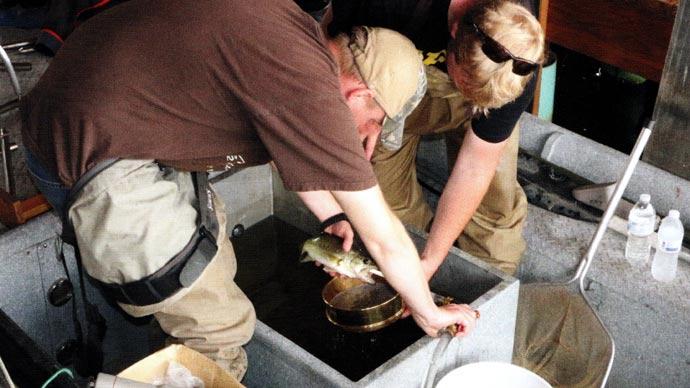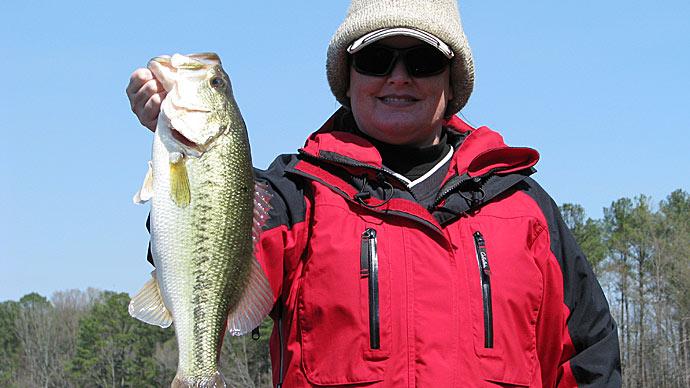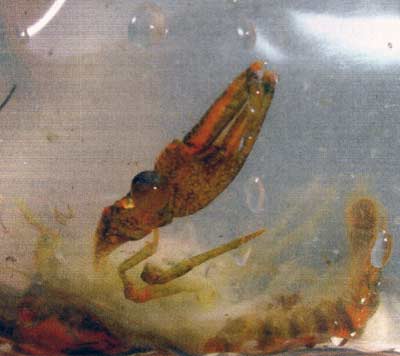
Figuring out what fish in a pond are eating can be a guessing game.
Pets and livestock eat right in front of people, and many mostly eat what they are given. However, my feisty yellow Labrador retriever once ate a rotting muskrat carcass right in front of me (that I most definitely did not give her), and I thought it was rather rude when she looked me in the eye and swallowed it as I was telling her to drop it!!
Many wild animals are comfortable enough with humans to eat in front of them, like birds and squirrels at a feeder. Other wild animals can be drawn to bait piles that have trail cameras posted around them. We have pictures of coyotes, bobcats, pine mar¬tens, and many other carnivores eating from local animal carcasses. Wild herbivores can be observed grazing with binoculars, even at a distance.
Fish obviously eat the bait on a fishhook, but that information can only be gained if fishing succeeds. Certainly, that's not everything a fish eats, though?! What do fish eat when humans aren't looking, which is most of the time for a fish?
There are several ways to figure out a fish's diet besides hoping to get a glance at them eating at the water's edge or knowing that a fish was caught on worms in that pond.
One of the more common ways for fisheries scientists, people who study fish as their job, to find out what the fish eat is a process called gastric lavage. To do this, the scientist takes a large syringe and gently forces a large amount of water into the fish's stomach. This causes the fish to regurgi¬tate (throw up) whatever is in its stomach.
Typically, the scientist will catch the sample (the throw-up) in a pan and pick through the stomach's contents to identify each food item.
It seems gross, but if we know what fish are eating in our ponds, we may be able to provide more of it.
The fish must be handled carefully during this process not to damage gills, slime coating, scales, or internal organs.
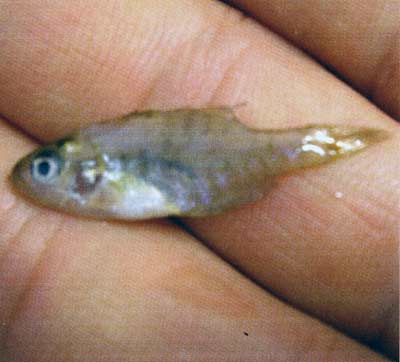
Additionally, precautions should be taken to minimize stress on the fish, which could also cause mortality (death) later due to the capture and lavage process. The lavage must be done gently and with great care, but when done correctly, the fish is not harmed. It is a fascinating process, and if you ever get a chance to see it happen in real life, I encourage you to take the opportunity.
Another way to determine what is being eaten by the fish in your pond is to examine stomach contents while cleaning the fish. Any fish caught to be eaten must be cleaned properly, which means the organs of the fish need to be removed from the body cavity, including the stomach. Anyone handy enough with a knife to clean a fish will also be able to carefully slice open the fish's stomach and look at the contents (whatever is in there). This method is not helpful if the goal includes studying a population of fish while keeping those fish alive; that is when gastric lavage is helpful. However, why not if you are a curious youngster (or elder, as the case often is) and with a pile of tasty fish that need to be cleaned and eaten?
Take an extra minute to cut open the stomach and determine what the fish eat. You may be surprised.
So, the pile of fish will not clean themselves, and the stomach contents will not simply reveal themselves! It's time to clean the fish, examine the stomach contents, and maybe even record some valuable pond management data.
First, determine who will safely handle the knife and the knife-safety rules for this situation. Then, gather the supplies you will need: the knife (or knives), a container for the cleaned fish, a surface to clean the fish on, a surface to spread the stomach contents onto, and a method for disposing of the contents and cleanings when finished. There are many ways to proceed; simply do the best you can! Clean the fish with the usual method but place the innards (guts) onto a semi-disposable tray, old pan, news¬papers lying on the grass or a dock, or even a smooth flat surface that can easily be cleaned off.
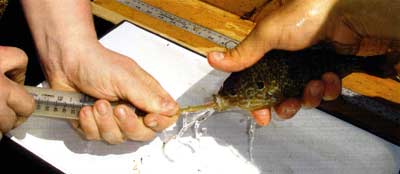
Study what you see. You can find the heart, the liver, the stomach, the intestines, and the kidneys if you know where to look.
Find the stomach and open it up into another pan or in a separate area of the surface. Discard the other organs once the stomach is emptied, spread the contents out, and examine them. If multiple fish will be cleaned, the contents could even be separated into piles of types of food; the largest pile will indicate a favored food for that pond in the current conditions. If data is being collected, information that might be of interest in the future includes the date, time, weather, water, and air temperature, whether the fish were easy or difficult to catch, current environmental conditions and weather events, bait used, and of course, what food was in the stomachs and what the most and least popular food items were. When the contents have been thoroughly examined, and the data is recorded, ensure all the waste is discarded correctly, any surfaces that were made dirty are cleaned, and everything is put away.
What a way to fish, learn, collect data and enjoy a tasty dinner from your pond! You can eat those tasty fillets, learn about the fish organs, and often see what your fish ate shortly after they did it. That's good science.
Christine Cornwell is a horse trainer who lives in upstate New York with her husband and son. She worked for the New York State Department of Environmental Conservation as a high school science teacher. Sharing her love of a healthy, natural world is a daily passion.
Reprinted with permission from Pond Boss Magazine

